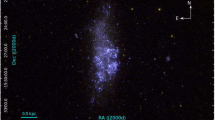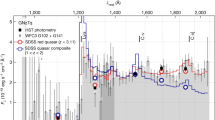Abstract
We present the far ultraviolet (FUV) imaging of the nearest Jellyfish or Fireball galaxy IC3418/VCC 1217, in the Virgo cluster of galaxies, using Ultraviolet Imaging Telescope (UVIT) onboard the AstroSat satellite. The young star formation observed here in the 17 kpc long turbulent wake of IC3418, due to ram pressure stripping of cold gas surrounded by hot intra-cluster medium, is a unique laboratory that is unavailable in the Milky Way. We have tried to resolve star forming clumps, seen compact to GALEX UV images, using better resolution available with the UVIT and incorporated UV-optical images from Hubble Space Telescope archive. For the first time, we resolve the compact star forming clumps (fireballs) into sub-clumps and subsequently into a possibly dozen isolated stars. We speculate that many of them could be blue supergiant stars which are cousins of SDSS J122952.66+112227.8, the farthest star (~17 Mpc) we had found earlier surrounding one of these compact clumps. We found evidence of star formation rate (4–7.4 × 10–4M☉ yr–1) in these fireballs, estimated from UVIT flux densities, to be increasing with the distance from the parent galaxy. We propose a new dynamical model in which the stripped gas may be developing vortex street where the vortices grow to compact star forming clumps due to self-gravity. Gravity winning over turbulent force with time or length along the trail can explain the puzzling trend of higher star formation rate and bluer/younger stars observed in fireballs farther away from the parent galaxy.









Similar content being viewed by others
References
Abadi M. G., Moore B., Bower R. G. 1999, MNRAS 308, 947
Agrawal P. C. 2006, Adv. Space Res. 38, 2989
Cardelli J. A., Clayton G. C., Mathis J. S. 1989, ApJ 345, 245
Cortese L., Marcillac D., Richard J. et al. 2007, MNRAS 376, 157
Croton Darren J., Springel V., White S. D. M. et al. 2006, MNRAS 365, 1
Croft S., van Breugel W., de Vries W. et al. 2006, ApJ 647, 1040
Elmegreen B. G., Elmegreen D. M. 1986, ApJ 311, 554
Etling D. 1989, Meteorology Atmos. Phys. 41, 157
Evans D. A., Fong W.-F., Hardcastle M. J. et al. 2008, ApJ 675, 1057
Fabian A. C. 2012, ARA&A 50, 455
Federrath C., Klessen R. S. 2012, ApJ 761, 156
Fumagalli M., Gavazzi G., Scaramella R., Franzetti P. 2011, A&A 528, A46
George K., Poggianti B. M., Gullieuszik M. et al. 2018, MNRAS 479, 4126
Gullieuszik M., Poggianti B. M., Moretti A. et al. 2017, ApJ 846, 27
Gunn J. E., Gott J. R. I. I. I. 1972, ApJ 176, 1
Hardcastle M. J., Croston J. H. 2020, NewAR, 8801539
Hester J. A. et al. 2010, ApJL 716, L14
Hopkins P. F., Hernquist L., Cox T. J. et al. 2006, ApJS 163, 1
Horváth Á, Bresky W., Daniels J. et al. 2020, J. Geophys. Res.: Atmospheres, 125(4), article id. e32121
Hota A., Rey S.-C., Kang Y. et al. 2012, MNRAS 422L, 38
Hota A., Konar C., Stalin C. S. et al. 2016, J. Astrophys. Astr. 37, 41
Indu G., Subramaniam A. 2011, A&A 535A, 115
Jáchym P., Kenney J. D. P., Ržuička A., Sun M., Combes F., Palouš J. 2013, A&A 556A, 99
Jáchym P., Kenney J. D. P., Sun M. et al. 2019, ApJ 883, 145
Jog Chanda J., Solomon P. M. 1992, ApJ 387, 152
Kapferer W., Sluka C., Schindler S., Ferrari C., Ziegler B. 2009, A&A 499, 87
Karachentsev I. D., Kaisina E. I., 2013, AJ, 146, 46
Kenney J. D. P., Geha M., Jáchym P. et al. 2014, ApJ 780, 119
Kennicutt R. C., Evans N. J. 2012, ARA&A,50, 531
Krumholz M. R. 2014, Phys. Rev 539, 49
Martin D. C., Seibert M., Neill J. D. et al. 2007, Nature 448, 780
McKee C. F., Ostriker E. C. 2007, ARA&A 45, 565
Müller A., Poggianti B., Pfrommer C. et al. 2021, Nat. Astron. 5, 159
Oey M. S., Massey P. 1995, ApJ 452, 210
Ohyama Y., Hota A. 2013, ApJ 767L, 29
Oosterloo T., van Gorkom J. 2005, A&A 437L, 19
Poggianti B. M., Moretti A., Gullieuszik M. et al. 2017, ApJ 844, 48
Salomé Q., Salomé P., Combes F., Hamer S. 2016, A&A 595A, 65
Sanders D. B., Mirabel I. F. 1996, ARA&A 34, 749
Santoro F., Oonk J. B. R., Morganti R., Oosterloo T. 2015, A&A 574A, 89
Smith Russell J., Lucey John R., Hammer Derek et al. 2010, MNRAS, 408, 1417
Springel V., Di Matteo T., Hernquist L. 2005, MNRAS 361, 776
Steinhauser D., Schindler S., Springel V. 2016, A&A 591A, 51
Sun M., Donahue M., Voit G. M. 2007, ApJ 671, 190
Tandon S. N et al. 2020, AJ, 159, 158
Tonnesen S., Bryan G. L. 2012, MNRAS 422, 1609
Vollmer B. et al. 2001, ApJ 561, 708
Wu B., Tan J. C. Nakamura F., Loo S. V., Christie D., Collins D. 2017, ApJ, 835, 137
Yagi M., Gu L., Fujita Y. et al. 2013, ApJ 778, 91
Yoshida M., Yagi M., Komiyama Y. et al. 2008, ApJ 688, 918
Zinnecker H., Yorke H. W. 2007, ARAA 45, 481
Zovaro H. R. M., Sharp R., Nesvadba N. P. H. et al. 2020, MNRAS 499, 4940
Acknowledgements
AH is thankful to the University Grants Commission (India) for the one-time start-up and monthly salary grants, under the Faculty Recharge Programme. This publication uses the data from the AstroSat mission of the Indian Space Research Organisation (ISRO), archived at the Indian Space Science Data Centre (ISSDC). This publication uses UVIT data processed by the payload operations centre at IIA. The UVIT is built in collaboration between IIA, IUCAA, TIFR, ISRO and CSA. Based on observations made with the NASA/ESA Hubble Space Telescope, and obtained from the Hubble Legacy Archive, which is a collaboration between the Space Telescope Science Institute (STScI/NASA), the Space Telescope European Coordinating Facility (ST-ECF/ESA) and the Canadian Astronomy Data Centre (CADC/NRC/CSA).
Author information
Authors and Affiliations
Corresponding author
Additional information
This article is part of the Special Issue on “AstroSat: Five Years in Orbit”.
Rights and permissions
About this article
Cite this article
Hota, A., Devaraj, A., Pradhan, A.C. et al. The sharpest ultraviolet view of the star formation in an extreme environment of the nearest Jellyfish Galaxy IC 3418. J Astrophys Astron 42, 86 (2021). https://doi.org/10.1007/s12036-021-09764-w
Received:
Accepted:
Published:
DOI: https://doi.org/10.1007/s12036-021-09764-w




